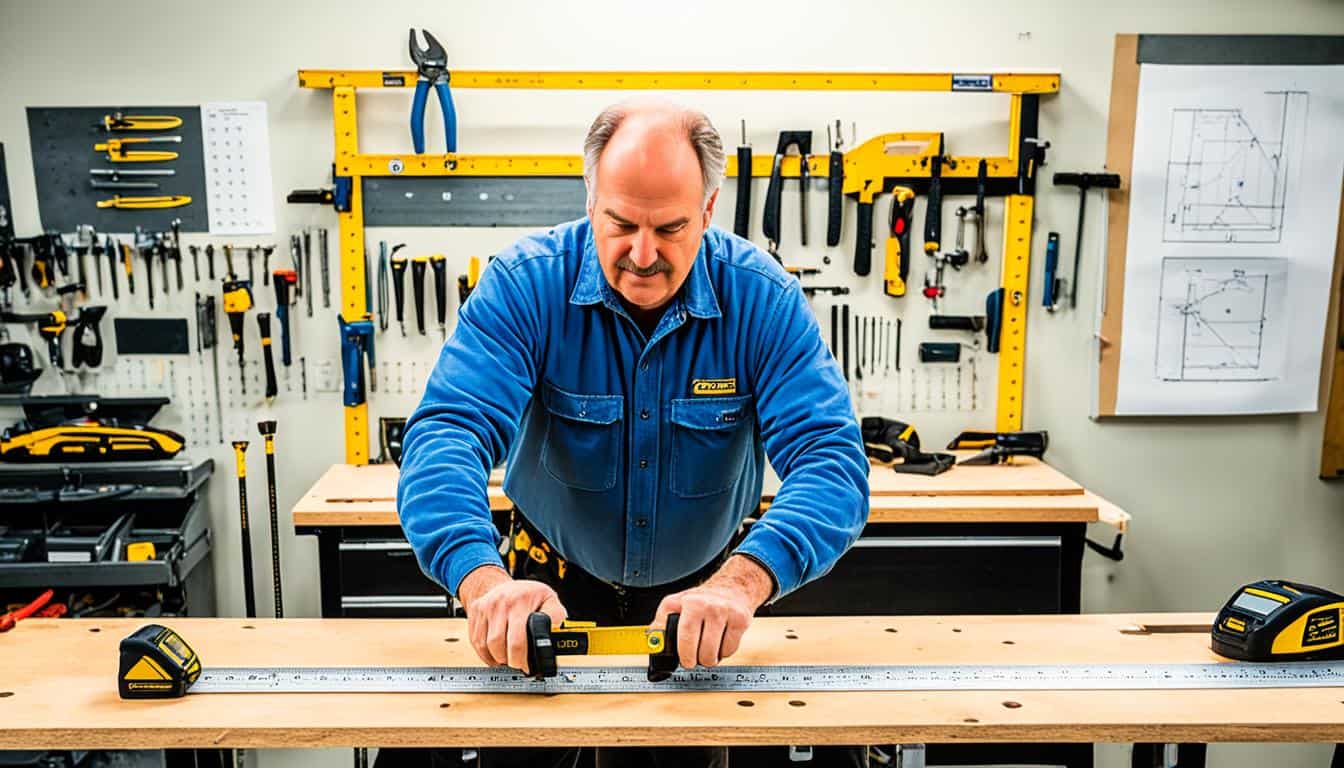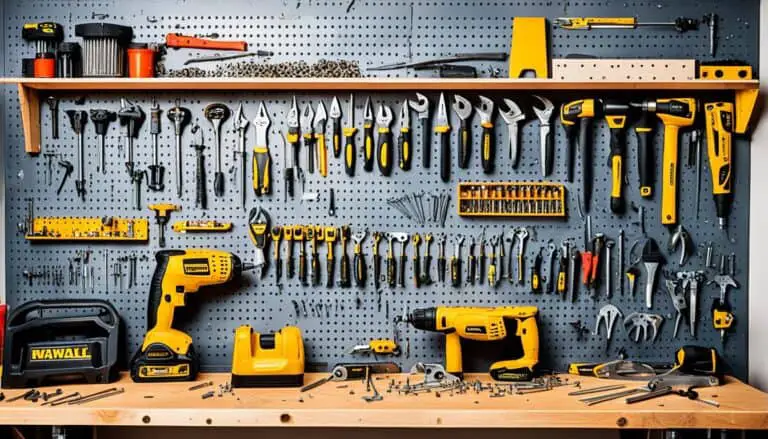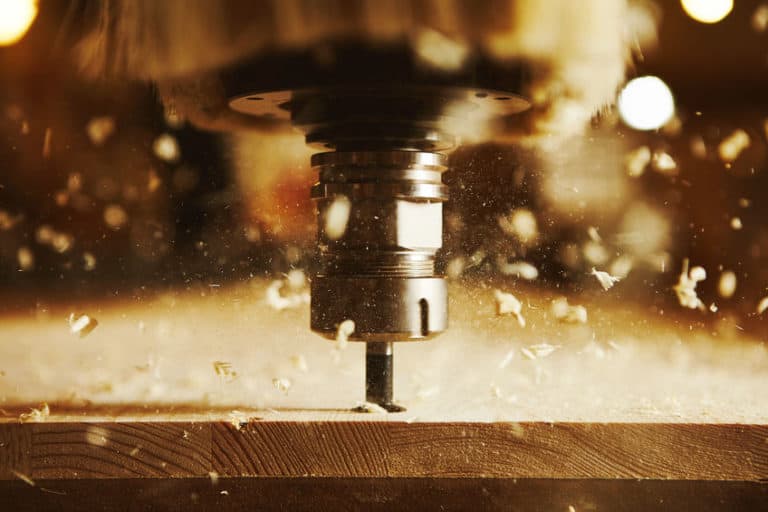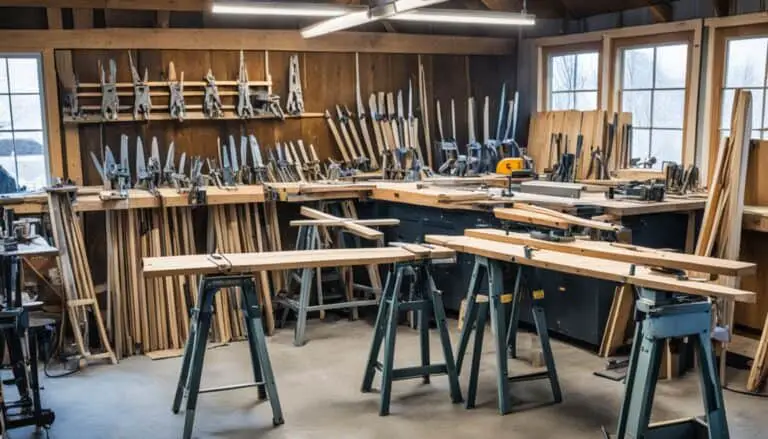Choosing the right height for your workbench is essential for maximizing comfort, efficiency, and overall well-being in various work environments. Whether you’re in woodworking, metalworking, electronics, or sewing, having the proper bench height can make a significant difference in your productivity and physical health.
When determining the optimal bench height, several factors should be taken into consideration. Body height, type of work, tools and equipment used, and posture and comfort all play a crucial role in finding the perfect bench height for you.
To help you navigate through this important decision, we have compiled a comprehensive guide that provides recommended workbench heights for different tasks and industries. We will also explore the benefits of adjustable bench heights, allowing you to customize your workspace to suit your specific needs.
So, whether you’re a seasoned professional or a hobbyist, read on to learn about the optimal bench height guidelines and how they can improve your work experience.
Key Takeaways:
- Choosing the right bench height is crucial for comfort, efficiency, and overall health in various work environments.
- Factors to consider when determining bench height include body height, type of work, tools/equipment used, and posture and comfort.
- Recommended workbench heights differ for woodworking, metalworking, electronics, and sewing.
- Adjustable workbenches provide flexibility for different users and tasks.
- By finding the optimal bench height, you can enhance productivity, prevent work-related injuries, and create a more rewarding work experience.
Factors to Consider When Choosing a Workbench Height
When it comes to selecting the height of your workbench, it’s crucial to consider several key factors. By taking into account these elements, you can ensure that your workbench is designed with ergonomic principles in mind, ultimately promoting productivity, reducing the risk of discomfort, and enhancing your overall work experience.
- Body Height: The ideal workbench height can significantly impact your comfort and productivity, preventing strain in your arms, back, and legs. A simple method to determine the best height for you is to stand next to your workbench and adjust its height so that when your palms face downward, they align with the surface without bending your arm. This position is generally best for hand tool woodworking, with the average height being between 36 and 38 inches for most light work. For detailed work that requires closer attention, adding a couple of inches to this height can improve comfort and efficiency (Sensible Digs).
- Type of Work: The nature of your tasks greatly influences the optimal height of your workbench. For fine work requiring precision, a higher workbench, approximately 37 to 40 inches, allows for resting elbows at 90 degrees and better support for your back. Light work suggests an average height of around 36 inches, facilitating forward lean and elbow rest. Heavy work, demanding more force, suggests a lower bench height, between 25.7 and 33.4 inches, to enhance stability and leverage (Sensible Digs).
- Tools and Equipment Used: Considering the tools you frequently use can help determine the ideal workbench height. For instance, detailed handcrafting tasks might benefit from a workbench around 30 inches high, allowing better leverage and weight distribution over your tools. Conversely, for tasks requiring attention to detail at or near eye level, a taller bench, between 30 and 37 inches, might be more appropriate, depending on your height and the materials you work with (Woodworking and Wood Treatening Guide).
- Posture and Comfort: An ergonomically designed workbench can mitigate fatigue and musculoskeletal issues. If woodworking is a hobby, a medium-height workbench between 34 and 36 inches is often suitable for various activities without compromising leverage or causing strain from leaning over too much. This average height can accommodate most tasks efficiently, especially in spaces that cannot fit multiple benches of varying heights (Woodworking and Wood Treatening Guide).

Here’s an illustration showing an ergonomic setup for a workbench designed for detailed woodworking tasks. This setup highlights key ergonomic features such as adjustable workbench height, tool arrangement within easy reach, and proper standing posture, aiming to enhance user engagement and comprehension of an effective workspace.
Adjustability and personalization are key to creating an ergonomic and productive workspace. Consider incorporating adjustable legs to cater to different tasks or working heights efficiently. This approach ensures your workbench can adapt to various projects without sacrificing quality or comfort.
For further information and more detailed guidance on selecting or adjusting your workbench height, you might find these articles from Sensible Digs (Sensible Digs) and Woodhappen (Woodworking and Wood Treatening Guide) particularly useful.
Recommended Workbench Heights for Woodworking
When it comes to woodworking, having the right workbench height is essential for ensuring comfort and efficiency during your projects. The standing workbench height range for woodworking typically falls between 36 to 39 inches (91 to 99 cm), providing a comfortable working position for activities such as cutting, planning, sanding, and working with smaller details. On the other hand, the sitting workbench height is generally set at 22 to 24 inches (56 to 61 cm), allowing for precision work and greater stability.
With a standing workbench height within this recommended range, you’ll be able to maintain proper posture while engaging in woodworking tasks, reducing strain on your back and neck. This height range also facilitates easy maneuverability and access to your tools and materials, enhancing overall productivity. Alternatively, the sitting workbench height is ideal for more detailed work, providing a stable and comfortable position for intricate woodworking tasks.
| Workbench Height | Standing Height (inches) | Standing Height (centimeters) | Sitting Height (inches) | Sitting Height (centimeters) |
|---|---|---|---|---|
| Recommended Range for Woodworking | 36-39 | 91-99 | 22-24 | 56-61 |
Having the right workbench height for woodworking can greatly enhance your crafting experience by reducing physical strain and allowing for more efficient and accurate work. Adjusting your workbench to the appropriate height will enable you to focus on the task at hand without discomfort or fatigue.
Recommended Workbench Heights for Metalworking
In the field of metalworking, it is essential to have workbenches that allow for secure and efficient handling of heavy machinery and precision tasks. Choosing the correct workbench height is crucial for promoting comfort, stability, and optimal ergonomics. Here are the recommended standing and sitting workbench heights for metalworking tasks:
Standing Workbench Height
The recommended standing workbench height for metalworking ranges between 34 to 37 inches (86 to 94 cm). This height range takes into account the physical demands of metalworking, allowing for easy maneuverability and control when working with heavy machinery and materials.
Sitting Workbench Height
For metalworking tasks that require precision or involve extended periods of focus, it is recommended to have a standard sitting workbench height of 20 to 22 inches (51 to 56 cm). This lower height allows for greater stability and supports a comfortable posture during detailed work.
By adhering to these recommended workbench heights for metalworking, you can create a workspace that prioritizes efficiency, safety, and overall well-being.
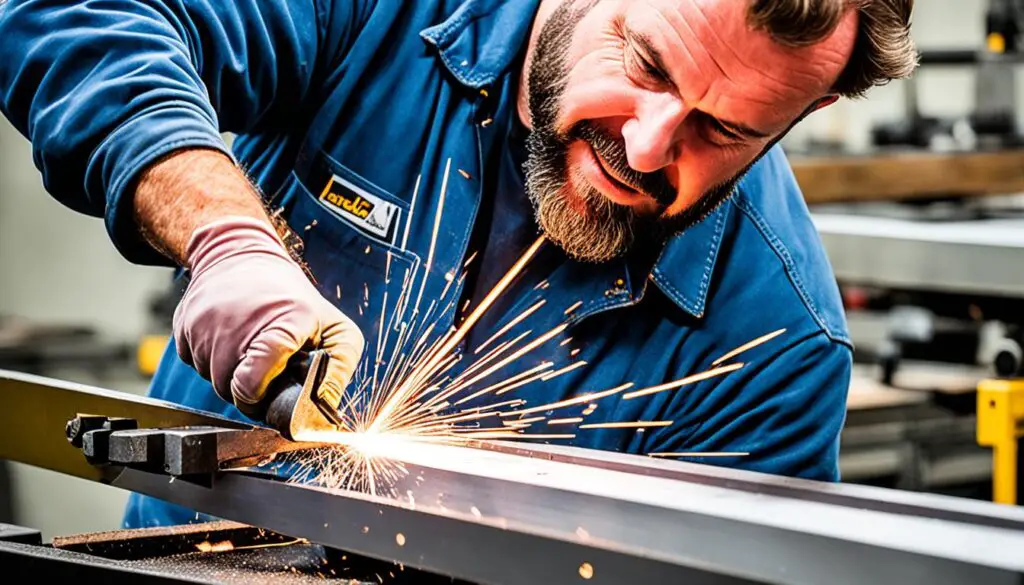
| Task | Standing Workbench Height (in inches) | Sitting Workbench Height (in inches) |
|---|---|---|
| Heavy Machinery Work | 34-37 | N/A |
| Precision Tasks | N/A | 20-22 |
Recommended Workbench Heights for Electronics
When it comes to working with electronics, having the right workbench height is crucial for optimal performance and comfort. Whether you’re tinkering with circuits, assembling components, or soldering intricate connections, finding the ideal standing and sitting heights can greatly enhance your productivity.
For standing work, it is recommended to set your electronics workbench height between 32 to 35 inches (81 to 89 cm). This range allows for easy access to tools, components, and soldering stations, minimizing strain on your back and arms. With a standing workbench at the appropriate height, you can efficiently work on projects without compromising your posture or comfort.
For more intricate electronics assembly or soldering tasks that require precision and steady hands, a sitting workbench height of around 18 to 20 inches (46 to 51 cm) is recommended. This lower work surface height allows you to have better control and stability, reducing the risk of accidental slips or imprecise soldering.
By adjusting your workbench height to match the task at hand, you can optimize your workspace for electronics-related activities, ensuring stability, ease of use, and accurate work. Whether you prefer standing or sitting while working with electronics, finding the right bench height can elevate your efficiency and overall experience.
Recommended Workbench Heights for Sewing
When it comes to sewing, having the right workbench height is crucial for maintaining comfort and promoting ergonomic practices. Whether you’re cutting fabrics or working with a sewing machine, finding the optimal standing and sitting workbench heights can make a significant difference in your sewing experience.
Standing Workbench Height for Sewing
For tasks such as cutting fabrics and preparing patterns, it is recommended to have a standing workbench height between 34 to 36 inches (86 to 91 cm). This range allows for comfortable fabric manipulation and cutting without straining your back. By having a workbench at the appropriate height, you can maintain good posture and reduce the risk of discomfort or injury during your sewing projects.
Sitting Workbench Height for Sewing
When using a sewing machine for extended periods of time, it is important to have a sitting workbench height that promotes proper ergonomics and prevents strain on your neck and back. The recommended sitting workbench height for sewing is typically between 28 to 30 inches (71 to 76 cm). This height allows for a relaxed position while working with the sewing machine, ensuring that you can focus on your stitching without any unnecessary strain on your body.
By adjusting your workbench to the appropriate sitting or standing height for sewing, you can create a comfortable and efficient workspace that enhances your sewing projects. Remember, maintaining good posture and taking breaks to stretch and move around are equally important for your overall sewing experience.
“Choosing the right workbench height for comfortable sewing.” Sewing Expert Magazine. July 2022
Adjusting Workbench Height
Workbenches are essential workstations that need to be adjusted in height to accommodate different users or tasks. The ability to adjust the workbench height ensures optimal ergonomics, promoting comfort, productivity, and overall well-being. There are two common methods for adjusting workbench height: manual adjustment and electric adjustment.
Manual Adjustment
Manual adjustment allows you to customize the workbench height according to your specific needs. This method typically involves using adjustable legs or inserts that can be easily modified to achieve the desired height. By manually adjusting the workbench height, you can create a comfortable and ergonomic workspace tailored to your individual preferences. This flexibility is especially beneficial in environments where multiple users with different height requirements share the same workbench.
Electric Adjustment
Electrically adjustable workbenches offer the convenience of motorized height changes with the simple push of a button. These workbenches are equipped with electric motors that smoothly raise or lower the work surface to the desired height. This type of adjustment provides precise control over the workbench height, making it easier to achieve the optimal ergonomic position for your specific tasks. Electrically adjustable workbenches are particularly useful in environments where frequent adjustments are required or for individuals with mobility limitations.
Overall, both manual and electric adjustment methods offer advantages in terms of customization and comfort. The choice between them depends on individual preferences, specific work requirements, and budget considerations. It’s essential to prioritize ergonomic design and adjust your workbench height to promote proper posture, reduce the risk of musculoskeletal disorders, and create a more productive and enjoyable work experience.
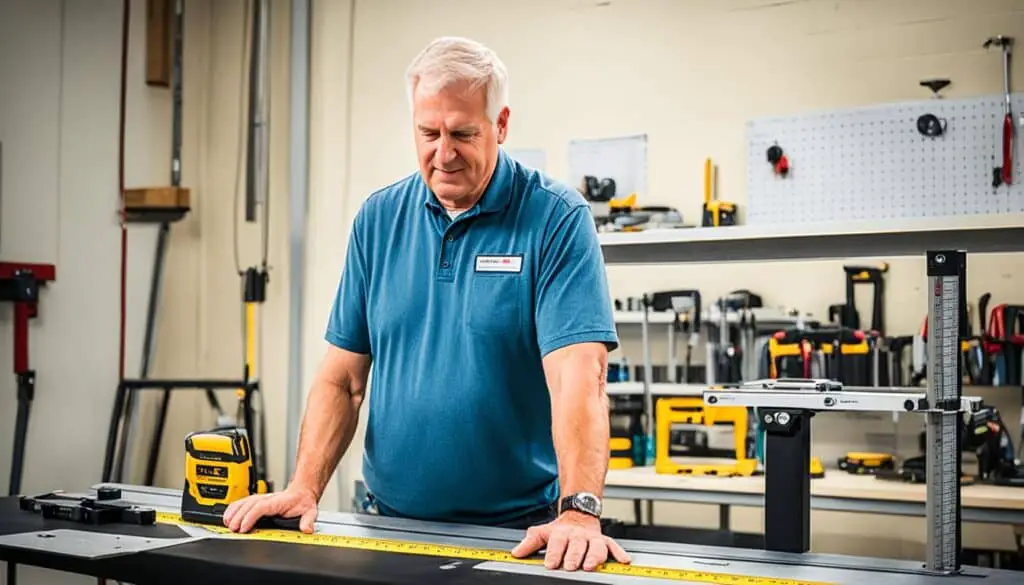
| Adjustment Method | Advantages | Disadvantages |
|---|---|---|
| Manual Adjustment |
|
|
| Electric Adjustment |
|
|
How Tall Should a Workbench Be for You?
To determine the best workbench height for you, consider your body height, the type of work you do, and the tools and equipment you use. It is important to find a workbench height that promotes a neutral body position, allowing for comfortable and efficient work without strain or discomfort.
Consider the following factors when determining your ideal workbench height:
- Body Height: Your workbench should be adjusted to a height that allows you to work with your arms in a relaxed and natural position. This helps prevent strain on your shoulders, neck, and back. Measure your height and use it as a reference when determining the workbench height.
- Type of Work: The nature of your work also influences the ideal workbench height. If you primarily work with hand tools, a lower workbench height may be suitable. If you work with power tools or perform detailed tasks, a higher workbench height may be more appropriate.
- Tools and Equipment: Consider the size and shape of the tools and equipment you use regularly. Ensure that your workbench height allows for comfortable and efficient use of these items without straining your body.
Remember, finding the right workbench height is a personal matter. Experiment with different heights and observe how your body feels during and after work. Adjust the height accordingly until you find what works best for you.
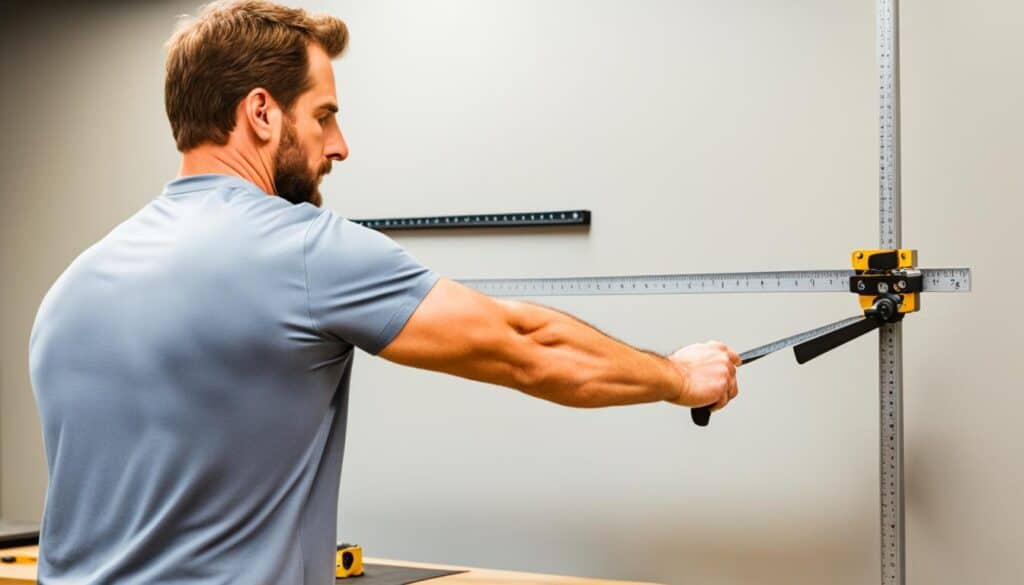
Conclusion
Choosing the right bench height is essential for creating a comfortable and efficient work environment while promoting overall health and well-being. Consideration of factors such as body height, type of work, tools and equipment used, and posture and comfort is crucial in determining the optimal workbench height.
By finding the perfect workbench height, you can significantly improve productivity and minimize the risk of work-related injuries. An ergonomic design that aligns with your body’s natural posture and movements is vital for maintaining proper alignment and reducing strain.
Remember, adjustable workbenches provide the flexibility and customization options necessary to cater to different individuals and tasks. Whether it’s manual adjustment through adjustable legs or electric adjustment with motorized controls, the ability to modify the workbench height ensures optimal ergonomics and user comfort.
Investing the time and effort into finding the right workbench height will not only enhance your work performance but also contribute to a more rewarding and fulfilling work experience. So, prioritize ergonomic design and optimal height when choosing your workbench, for it is the foundation of a productive and healthy workspace.
FAQ
Why is bench height important?
Choosing the appropriate bench height is crucial for promoting efficiency, comfort, and overall health in various work environments.
What factors should I consider when choosing a workbench height?
Factors to consider include body height, type of work, tools and equipment used, and posture and comfort.
What are the recommended workbench heights for woodworking?
The recommended standing workbench height for woodworking is between 36 to 39 inches (91 to 99 cm), while the sitting workbench height is typically 22 to 24 inches (56 to 61 cm).
What are the recommended workbench heights for metalworking?
The recommended standing workbench height for metalworking is between 34 to 37 inches (86 to 94 cm), while the sitting workbench height is 20 to 22 inches (51 to 56 cm).
What are the recommended workbench heights for electronics?
The recommended standing workbench height for electronics is between 32 to 35 inches (81 to 89 cm), while the sitting workbench height is around 18 to 20 inches (46 to 51 cm).
What are the recommended workbench heights for sewing?
The recommended standing workbench height for sewing is between 34 to 36 inches (86 to 91 cm), while the sitting workbench height is 28 to 30 inches (71 to 76 cm).
Can workbenches be adjusted in height?
Yes, workbenches can be adjusted in height to accommodate different users or tasks. There are both manual and electrically adjustable options available.
How can I determine the best workbench height for me?
To determine the best workbench height for you, consider your body height, the type of work you do, and the tools and equipment you use.
What is the importance of ergonomic design in workbenches?
Ergonomic design in workbenches aims to promote a neutral body position, allowing for comfortable and efficient work without strain or discomfort.
How can choosing the right bench height benefit me?
Choosing the right bench height can improve efficiency, prevent work-related injuries, and create a more rewarding work experience in various work environments.


